What happens if a fire alarm goes off in your building right now? Would everyone get out safely?
That question highlights the role emergency exit doors play in every commercial property.
As someone who works with building owners and engineering teams on doors and windows, I’ve seen how safety standards are applied in real projects. My work has given me insight into how exit doors affect both compliance and real-world safety.
In this article, you will learn why emergency exit doors are essential, what standards apply, and how they protect your guests and property. By the end, your need for clear, practical guidance will be met.
Planning for emergencies is the difference between safety and liability.
So, let’s get started!
1. What Are Commercial Emergency Exit Doors?
Commercial emergency exit doors are built for one purpose. They help people get out quickly and safely during an emergency. They are different from regular entry doors you use every day. These doors open outward, stay clear of blockages, and are made to handle panic situations when people rush out.
I have seen projects where owners treated them like any other door. That mistake cost time and money later. You and your team should view them as part of a safety system, not just another piece of hardware. Knowing what they are and how they function matters for every commercial property you manage.
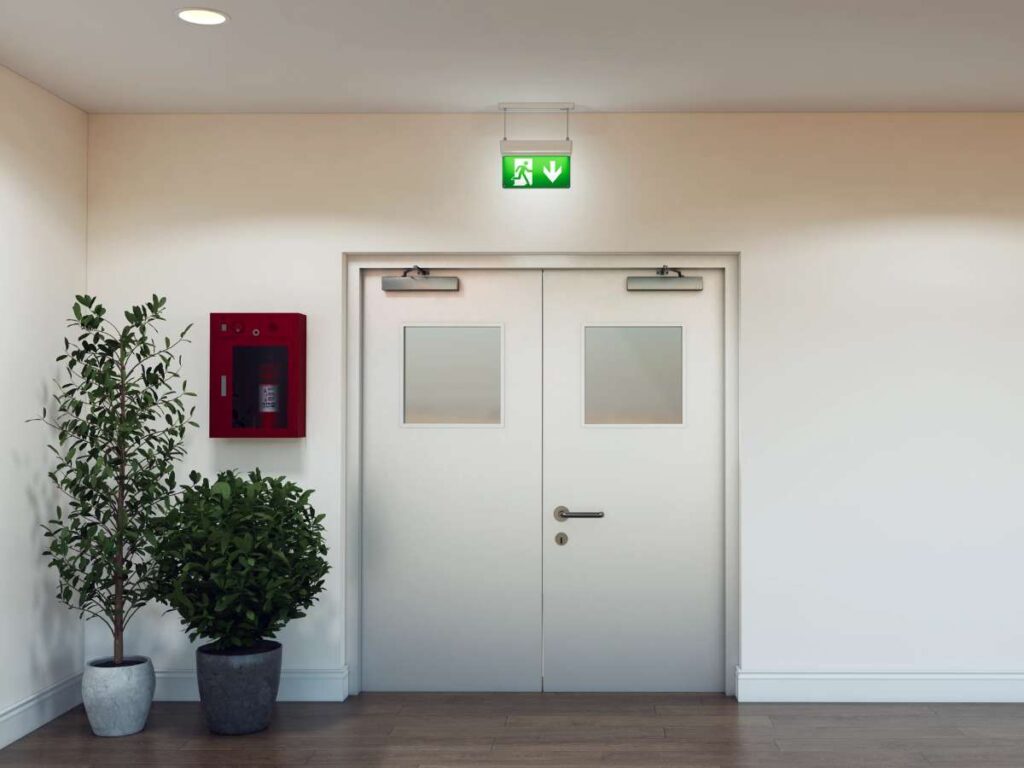
2. Types of Commercial Emergency Exit Doors
Not every hotel has the same layout, so the type of exit door that works in one property may not fit another. I’ve walked through hotels big and small, and I can tell you the right choice depends on guest safety, space planning, and local codes. Let’s look at the main types you should know about.
Swing Doors
These are the most common type of emergency exit door. They open outward to allow a quick and safe escape. Hotels often use them at the end of hallways or in stairwells. They are simple, reliable, and easy for guests to understand in stressful moments.
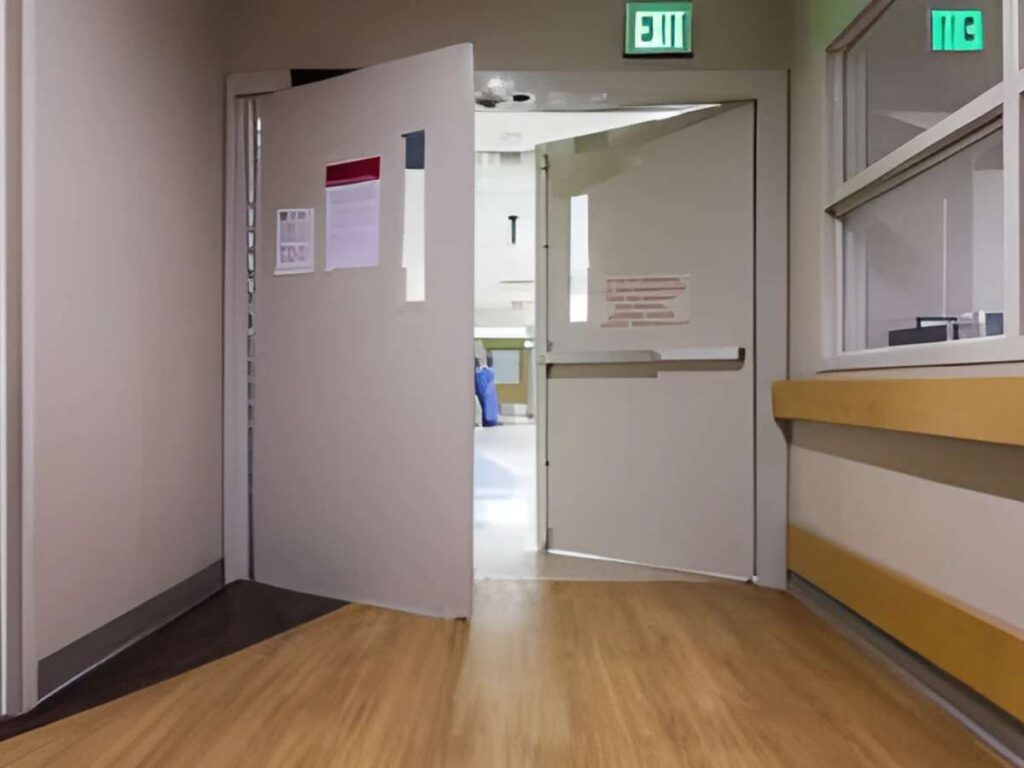
Panic Bar Doors
A panic bar door opens with a horizontal push bar, making it easy to use, even in low light or smoke. I’ve seen hotels where this setup made all the difference during drills because guests didn’t waste time fumbling with handles. They also reduce the chance of crowding since people can move through quickly.

Fire-Rated Doors
Fire-rated doors are built to withstand flames and heat for a set amount of time. This delay gives guests and staff more time to reach safety.
In hotels with large dining halls or conference rooms, these doors often connect directly to outside exits. They are not just about getting out fast, they are about slowing down fire spread too.
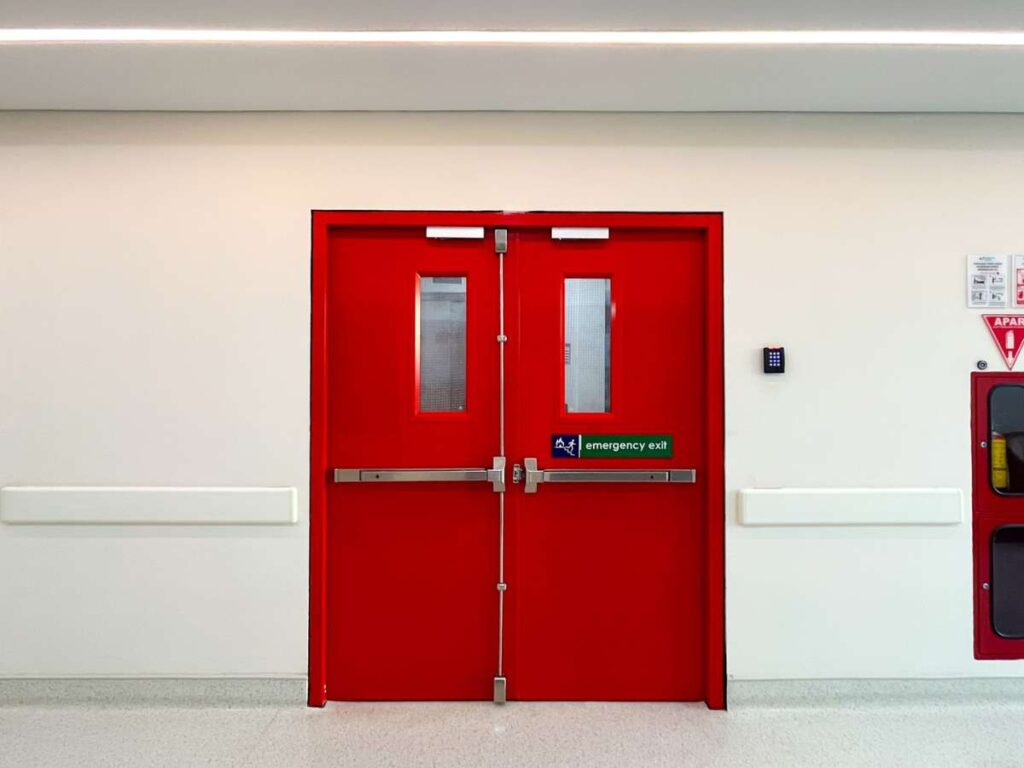
Sliding Exit Doors
Some modern hotels with limited space use sliding exit doors. While less common, they are helpful in areas where swing doors would block pathways or equipment.
You’ll need to check local codes carefully because not all regions allow them for emergency exits. I’ve noticed they work best in properties with compact layouts.
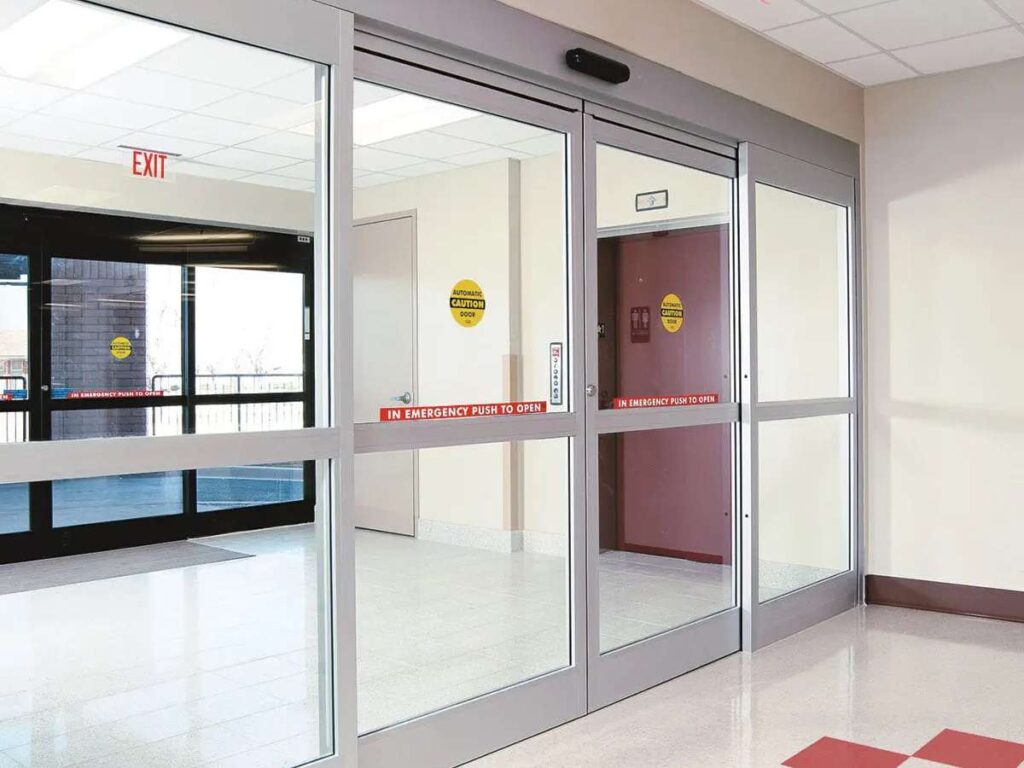
Double Exit Doors
Double exit doors are wider and designed to handle larger crowds. In hotels with banquet halls, event centers, or busy lobbies, these doors prevent bottlenecks. They also make it easier for guests with luggage or wheelchairs to move through without slowing others down.
If your property hosts big gatherings, this option is worth serious thought.
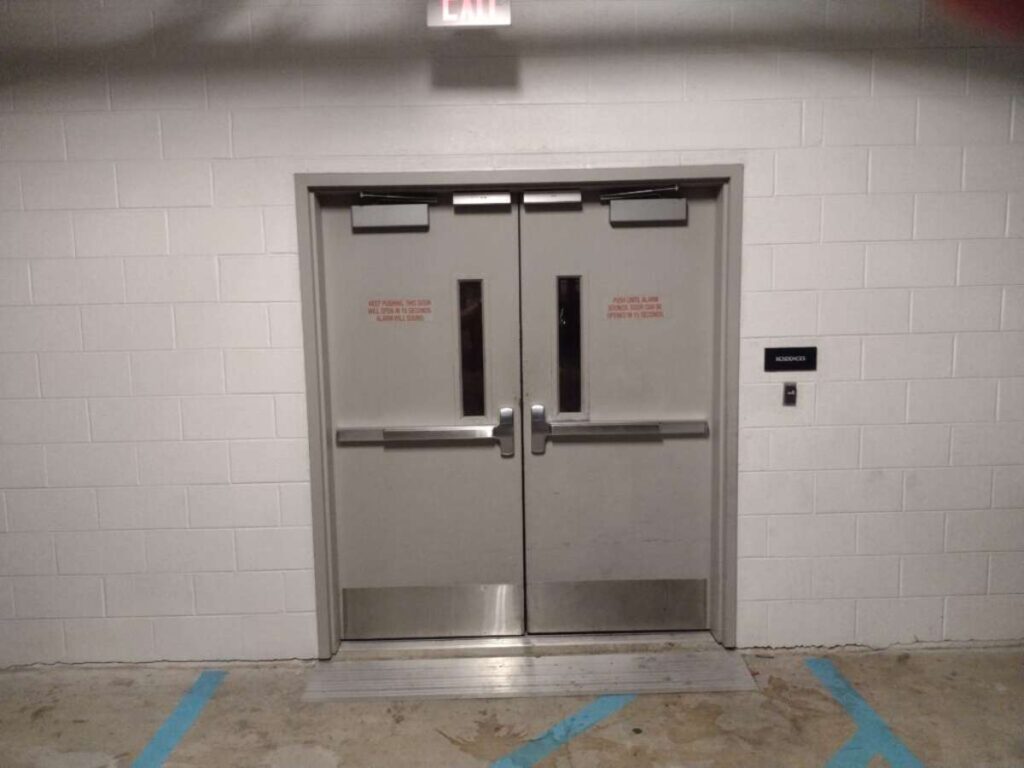
3. Materials Used in Commercial Emergency Exit Doors
When I walk into a project site, one of the first things I check is what the exit doors are made of. The material tells me right away how long the door will last, how much care it will need, and whether it will pass inspection.
Here are the most common materials used in commercial emergency exit doors.
| Material | Fire Rating | Durability | Weight | Maintenance | Appearance |
| Steel | Up to 3 hours | Very high, resists impact | Heavy | Low, occasional painting | Industrial look |
| Aluminum | Limited (30–60 mins with core) | Good, but less strong than steel | Light | Very low, resists rust | Can include glass panels |
| Fiberglass | 60–90 mins | High, resists warping and chemicals | Medium | Very low, no painting needed | Plain, utilitarian |
| Wood with Fire-Rated Core | Up to 90 mins | Moderate, weaker against impact and moisture | Medium-heavy | Medium, needs sealing or finish | Warm, traditional look |
From my experience, most property teams balance fire rating and maintenance first, then think about appearance. Steel may win for heavy use buildings, while aluminum or fiberglass work better in places where weight and corrosion matter. Wood with a fire core is still chosen when style is part of the project.
If you need doors that use durable materials and are built for commercial safety, Vallisco is a manufacturer worth considering. Their doors are tested for compliance, designed to handle heavy daily use, and available in multiple materials to match different property needs.
4. Key Features to Look For
I know from working with property owners that choosing exit doors can feel like checking boxes for compliance. But if you dig deeper, the right features save you money, reduce headaches, and protect people in real emergencies. Here are the features I pay the most attention to, and you should too.
Fire Rating
A commercial emergency exit door is only as good as its fire rating. This rating tells you how long the door can hold back flames before failing. I always look for at least 60 minutes in smaller properties, and higher for hotels or larger buildings.
Fire inspectors will check this, so having the right rating saves you from failed inspections. Think of this as the backbone of safety.
Panic Hardware
Panic bars and push pads are not just accessories. They are required for most exit doors, and they make the difference when people are rushing out in fear. I’ve seen doors fail tests because the hardware jammed or wasn’t installed correctly.
Your team should test these bars regularly, because in an emergency, smooth operation is everything. Don’t cut corners here, even if the cheaper option looks tempting.
Durability and Material Strength
Not every door will face the same conditions. A greenhouse may deal with moisture, while a hotel door takes daily wear from hundreds of guests. This is where the material matters, but it is also about hinges, frames, and seals.
Ease of Maintenance
A steel door might last decades but will need paint touch-ups. Aluminum and fiberglass take less care but can still show wear if ignored.
The easier the door is to maintain, the less chance it will fail during an emergency. You and your team need doors that fit into your maintenance schedule, not ones that become another problem to manage.
5. Placement and Installation Guidelines
Placement and installation are where good exit doors succeed or fail. A strong door is only effective if people can find it fast and if it works the way it should. Over the years, I’ve seen properties pass or fail inspections simply because of these details. These are the areas I always highlight when I talk with owners and engineers.
Visibility and Access
Emergency exit doors should always be easy to see and reach. If people have to search for them, they’re already in danger. I’ve walked properties where doors were hidden behind furniture or blocked by equipment, and those setups would never pass inspection.
Think about how quickly someone could reach the door in low light or with smoke in the air. Placement is about safety in real situations, not just meeting code.
Correct Outward Swing
Doors should always swing outward so crowds can move through without resistance. Projects that miss this detail often face costly corrections later.
Imagine people pressing against a door that only opens inward, it creates panic instead of safety. Checking this early prevents serious risks and expensive changes down the road.
Professional Installation
A door is only as reliable as its installation. Frames must be anchored, panic hardware should align, and seals need to hold. I’ve inspected doors that looked fine on day one but sagged within a year because of poor workmanship.
That’s why working with installers who understand fire-rated and safety doors matters. Cutting corners here almost always leads to bigger problems later.
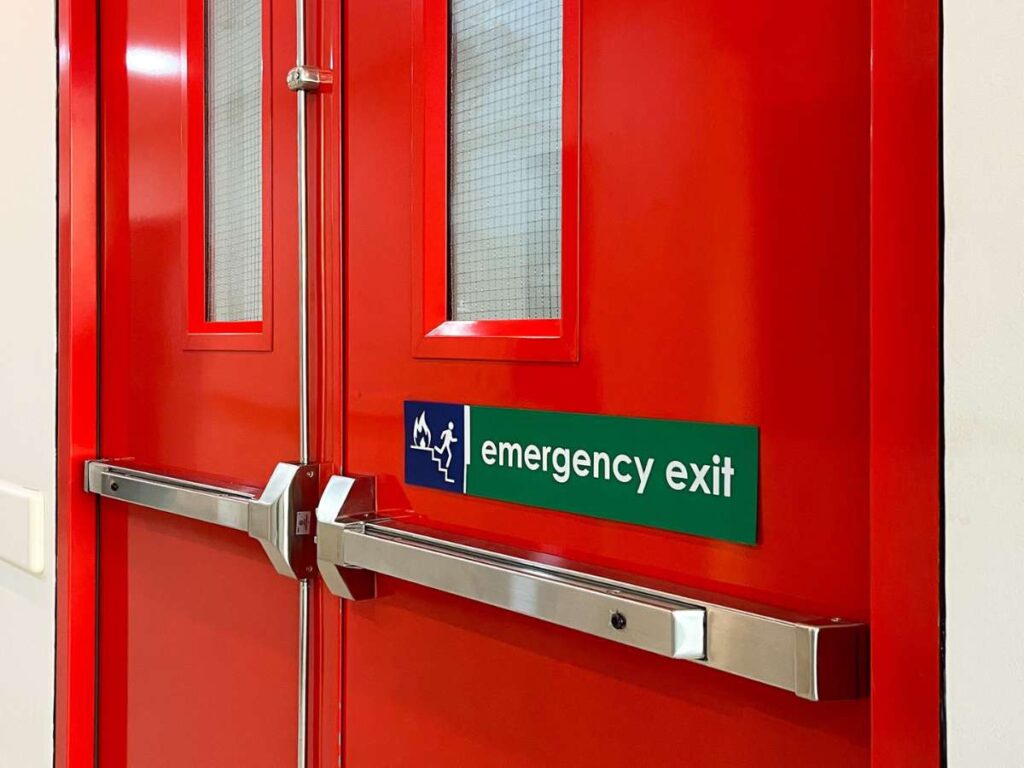
6. Safety Codes and Legal Requirements
Codes and regulations can feel like red tape, but they set the baseline for keeping people safe. On past projects, I noticed that skipping or delaying compliance often leads to bigger problems later. Let’s break these requirements down in a clear, practical way.
Fire Safety Standards
Most countries have strict fire codes that outline where and how many emergency exits a building must have. These rules are enforced through inspections, and fines come quickly when a property falls short.
In some cases, operations can be suspended until the issue is fixed. Meeting fire safety standards keeps both your business and your people protected.
Accessibility Requirements
Emergency exits must be usable by everyone. That means clear pathways, doors that are easy to operate, and signage that works under stress.
I once came across a hotel where the exits technically existed but were impossible for certain guests to use. That kind of setup creates both safety risks and potential legal challenges.
Regular Inspections and Enforcement
Having the right doors is only the first step. They must also work properly every time. Inspectors look for broken latches, missing signage, or routes blocked by storage. Businesses often face penalties simply because checks are not done regularly.
Staying ahead with inspections keeps your doors reliable and your property in good standing with regulators.
7. How To Choose The Right Commercial Emergency Exit Doors
Choosing the right exit doors is not just about picking something from a catalog. I’ve learned that what works in one property can be a poor fit for another. The decision comes down to your building’s layout, your guest needs, and the safety codes you must meet. Here’s how to choose the right one.
Match the Door to Space
The layout of your property should guide your choice. A banquet hall that seats hundreds needs double exit doors to handle the flow, while a narrow corridor may only require a single swing door.
I always suggest walking the routes yourself and imagining how people will move in an emergency. That simple exercise often points to the right option.
Balance Safety and Security
Exit doors should give people an easy way out but also protect the building from unwanted entry. Panic bars, for example, let guests leave quickly without leaving the property open to outsiders.
Safety has to come first, but security should not be ignored either. If you are comparing options, manufacturers like Vallisco focus on doors that meet fire codes and heavy daily use, which makes them a strong choice for hotels.
Think About Long-Term Use
Emergency exit doors are built for rare events, but they still take a beating from daily use. Pick materials and hardware that can stand up to constant traffic in a hotel setting. If you cut corners here, you will face more repairs and replacements down the line. A door that lasts is worth more than one that only looks good on day one.
Conclusion
When I think back to that fire drill where people struggled to find an exit, it reminds me how small details matter most.
Emergency exit doors are not just hardware, they are lifelines for staff and guests. This guide showed you why they matter, the rules you must follow, and how to choose the right type for your property.
If you want trusted doors built for hotels and commercial spaces, Vallisco can help.
Contact us today and let’s build something great together!
Learn More: Recommended Reads
Want to see more products? We’ve got plenty of options that might just be the perfect fit for you:
Still haven’t found what you’re looking for? Don’t hesitate to contact us. We’re available around the clock to assist you.







